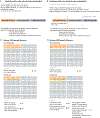Adaptation of a Tailored Lung Cancer Screening Decision Aid for People With HIV
- PMID: 39391570
- PMCID: PMC11465906
- DOI: 10.1016/j.chpulm.2024.100044
Adaptation of a Tailored Lung Cancer Screening Decision Aid for People With HIV
Abstract
Background: People with HIV are both at elevated risk of lung cancer and at high risk of multimorbidity, which makes shared decision-making (SDM) for lung cancer screening (LCS) in people with HIV complex. Currently no known tools have been adapted for SDM in people with HIV.
Research question: Can an SDM decision aid be adapted to include HIV-specific measures with input from both people with HIV and their providers?
Study design and methods: This study used qualitative methods including focus groups of people with HIV and interviews with HIV care providers to adapt and iterate an SDM tool for people with HIV. Eligible participants were those with HIV enrolled in an HIV primary care clinic who met age and smoking eligibility criteria for LCS and HIV care providers at the clinic. Both the focus groups and interviews included semistructured discussions of SDM and decision aid elements for people with HIV. We used a framework-guided thematic analysis, mapping themes onto the Health Equity Implementation framework.
Results: Forty-three people with HIV participated in eight focus groups; 10 providers were interviewed. Key themes from patients included broad interest in adapting LCS SDM specifically for people with HIV, a preference for clear LCS recommendations, and the need for positive framing emphasizing survival. Providers were enthusiastic about personalized LCS risk assessments and point-of-care tools. Both patients and providers gave mixed views on the usefulness of HIV-specific risk measures in patient-facing tools. Themes were used to adapt a personalized and flexible SDM tool for LCS in people with HIV.
Interpretation: People with HIV and providers were enthusiastic about specific tools for SDM that are personalized and tailored for people with HIV, that make recommendations, and that inform LCS decision-making. Divergent views on presenting patient-facing quantitative risk assessments suggests that these elements could be optional but available for review. This tool may have usefulness in complex decision-making for LCS in this population and currently is being evaluated in a pilot prospective trial.
Keywords: HIV; HIV infections; early detection of cancer; health care disparities; health services accessibility; lung neoplasm diagnosis; lung neoplasms; qualitative research.
Figures

Similar articles
-
How Health-Care Organizations Implement Shared Decision-making When It Is Required for Reimbursement: The Case of Lung Cancer Screening.Chest. 2021 Jan;159(1):413-425. doi: 10.1016/j.chest.2020.07.078. Epub 2020 Aug 13. Chest. 2021. PMID: 32798520 Free PMC article.
-
Clinician Perceptions on Using Decision Tools to Support Prediction-Based Shared Decision Making for Lung Cancer Screening.MDM Policy Pract. 2024 May 20;9(1):23814683241252786. doi: 10.1177/23814683241252786. eCollection 2024 Jan-Jun. MDM Policy Pract. 2024. PMID: 38779527 Free PMC article.
-
A protocol for a cluster randomized trial of care delivery models to improve the quality of smoking cessation and shared decision making for lung cancer screening.Contemp Clin Trials. 2023 May;128:107141. doi: 10.1016/j.cct.2023.107141. Epub 2023 Mar 5. Contemp Clin Trials. 2023. PMID: 36878389 Free PMC article.
-
Shared decision-making conversations and smoking cessation interventions: critical components of low-dose CT lung cancer screening programs.Transl Lung Cancer Res. 2018 Jun;7(3):254-271. doi: 10.21037/tlcr.2018.05.10. Transl Lung Cancer Res. 2018. PMID: 30050764 Free PMC article. Review.
-
The American Cancer Society National Lung Cancer Roundtable strategic plan: Current challenges and future directions for shared decision making for lung cancer screening.Cancer. 2024 Dec 1;130(23):3996-4011. doi: 10.1002/cncr.35382. Epub 2024 Sep 20. Cancer. 2024. PMID: 39302231 Review.
Cited by
-
The Use of a Tailored Decision Aid to Improve Understanding of Lung Cancer Screening in People With HIV.Chest. 2025 Jan;167(1):259-269. doi: 10.1016/j.chest.2024.07.147. Epub 2024 Jul 29. Chest. 2025. PMID: 39084517
References
-
- de Koning HJ, van der Aalst CM, de Jong PA, et al. Reduced lung-cancer mortality with volume CT screening in a randomized trial. N Engl J Med. 2020;382(6):503–513. - PubMed
Grants and funding
LinkOut - more resources
Full Text Sources
Miscellaneous
